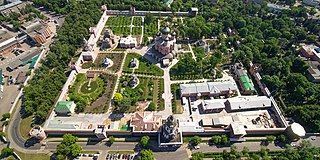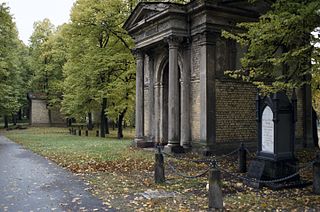
Red Square is one of the oldest and largest squares in Moscow, the capital of Russia. Owing to its historical significance and the adjacent historical buildings, it is regarded as one of the most notable and important squares in Europe and the world. It is located in Moscow's historic centre, in the eastern walls of the Kremlin. It is the city landmark of Moscow, with famous buildings such as Saint Basil's Cathedral, Lenin's Mausoleum and the GUM. In addition, it has been a UNESCO World Heritage Site since 1990.

Tikhvin Cemetery is a historic cemetery in the centre of Saint Petersburg. It is part of the Alexander Nevsky Lavra, and is one of four cemeteries in the complex. Since 1932 it has been part of the State Museum of Urban Sculpture, which refers to it as the Necropolis of the Masters of Art.

Old Chapel Hill Cemetery is a graveyard and national historic district located on the campus of the University of North Carolina at Chapel Hill in Chapel Hill, North Carolina.

Danilov Monastery is a walled monastery on the right bank of the Moskva River in Moscow. Since 1983, it has functioned as the headquarters of the Russian Orthodox church and the official residence of the Patriarch of Moscow and all Rus'.

Donskoy Monastery is a major monastery in Moscow, founded in 1591 in commemoration of Moscow's deliverance from the threat of an invasion by the Crimean Khan Kazy-Girey. Commanding a highway to the Crimea, the monastery was intended to defend southern approaches to the Moscow Kremlin.
Rogozhskoe cemetery in Moscow, Russia, is the spiritual and administrative center of the largest Old Believers denomination, called the Russian Orthodox Old-Rite Church. Historically, the name cemetery was applied to the whole Old Believer community, with living quarters, cathedral, almshouses, libraries, archives and the Old-Rite Institute. Actual 12 hectare cemetery is now a non-denominational municipal burial site; the Old Believers operate a closed spiritual community in the southern part of the historical Rogozhsky township, while Russian Orthodox church operates church of Saint Nicholas, located between the cemetery and Old Believer territory.

Preobrazhenskoye Cemetery is a cemetery in the eastern part of Moscow long associated with Old Believers. It was inaugurated by a Fedoseevtsy merchant in 1777 as a plague quarantine disguising the Bespopovtsy monastery. At that time the territory of the cemetery was located outside Moscow, but near its border. The cemetery soon became the spiritual and administrative center of all the Fedoseevtsy in Russia.

Vvedenskoye Cemetery is a historic cemetery in Lefortovo District of Moscow in Russia.

The Kopli cemetery was Estonia's largest Lutheran Baltic German cemetery, located in the suburb of Kopli in Tallinn. It contained thousands of graves of prominent citizens of Tallinn and stood from 1774 to shortly after World War II, when it was completely flattened and destroyed by the Soviet occupation authorities governing the country at the time. The former cemetery is now a public park.

Mõigu cemetery was a large Baltic German cemetery, located in the Tallinn suburb of Mõigu in Estonia. It served as the primary burial ground for the usually wealthy and noble citizens of the Toompea parish of Tallinn. Containing numerous graves, it stood for over 170 years from 1774 to shortly after World War II when it was completely flattened and destroyed by the Soviet occupation authorities governing the country at that time.

The Remembrance Day for the Victims of Political Repression is an annual day when victims of political repression in the Soviet Union are remembered and mourned across the Russian Federation.

The Great Cemetery was formerly the principal cemetery of Riga in Latvia, established in 1773. It was the main burial ground of the Baltic Germans in Latvia.

The New Cemetery is a cemetery complex in Belgrade, Serbia, with a distinct history. It is located in Ruzveltova street in Zvezdara municipality. The cemetery was built in 1886 as the third Christian cemetery in Belgrade and as the first architecturally and urbanistically planned cemetery in Serbia.

The Armenian Holy Church of Nazareth is an 18th-century Armenian Apostolic church in Kolkata, India, serving as the centre of the Armenian Community in Kolkata and the seat of the Armenian Vicariate of India and the Far East. It is affiliated with the Mother See of Holy Etchmiadzin of the Armenian Apostolic Church. It was first built in the year 1688 and rebuilt in 1724 on the old cemetery of the Armenian community, through the efforts of Agha Nazar after the original wooden structure perished in a fire in 1707.

Askold's Grave is a historical park on the steep right bank of the Dnipro River in Kyiv between Mariinskyi Park and the Kyiv Pechersk Lavra complex.

Events from the year 1771 in Russia

The Pyatnitskoye Сemetery is one of the graveyards in the Russian town Kaluga. It is among the oldest and largest resting places in the city. On the territory of the cemetery is the Memorial to the Heroes of the Great Patriotic War.

The Church of St. Nicholas in Tolmachi is both a Russian Orthodox house church and museum that is part of the State Tretyakov Gallery located in Moscow. The church is home to several religious relics and icons, including the culturally important Our Lady of Vladimir.



















